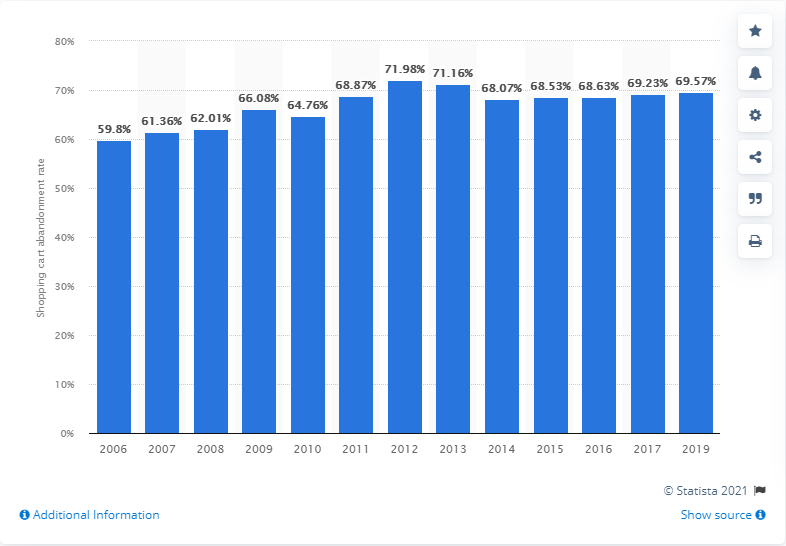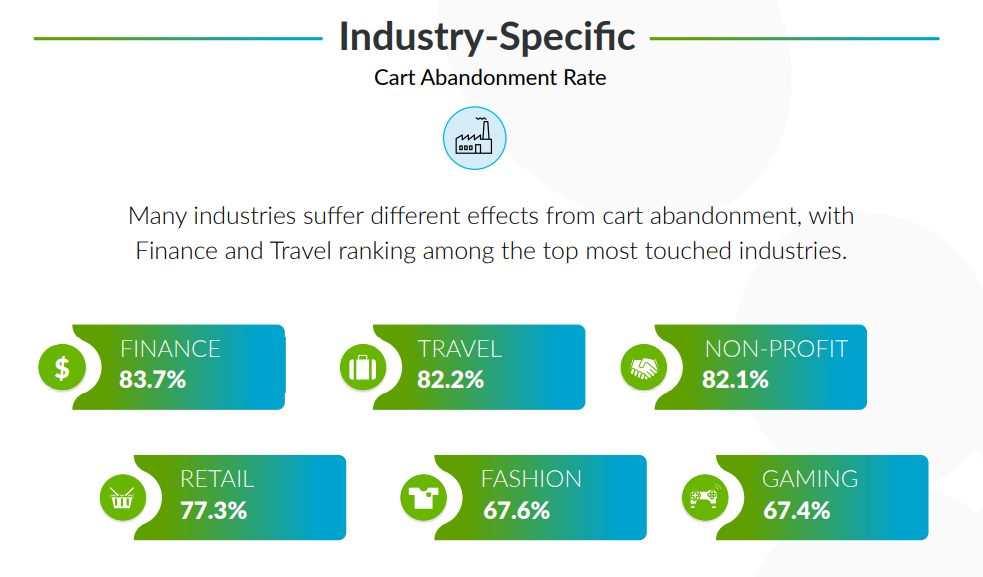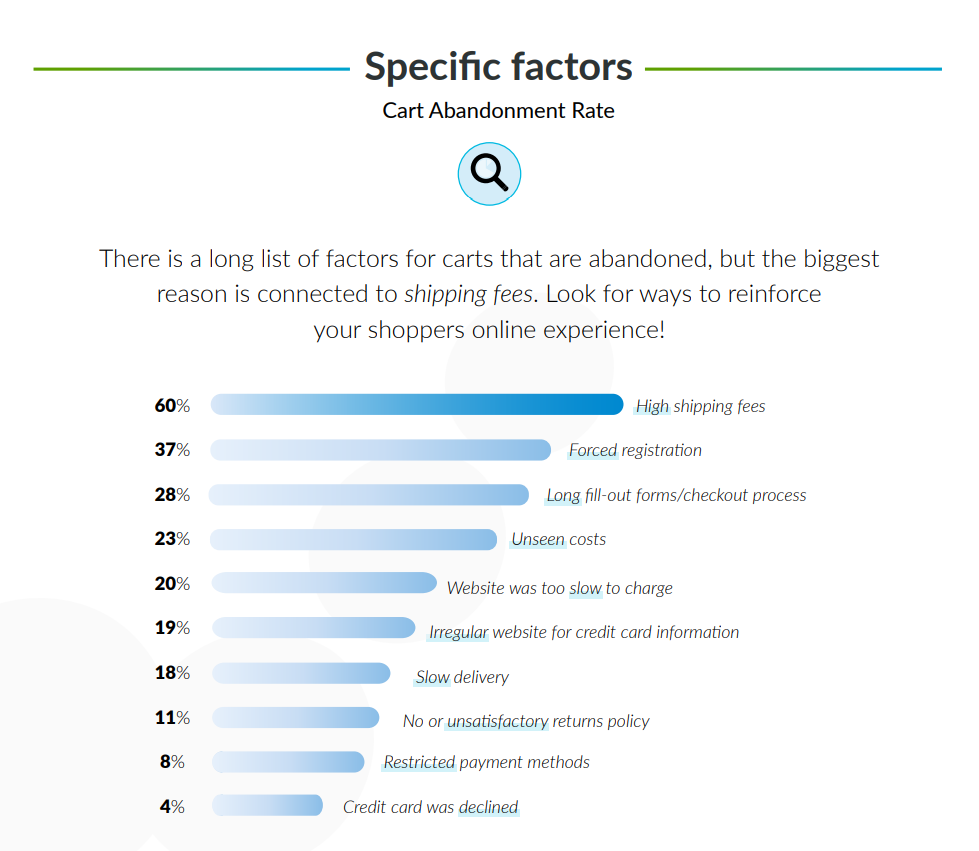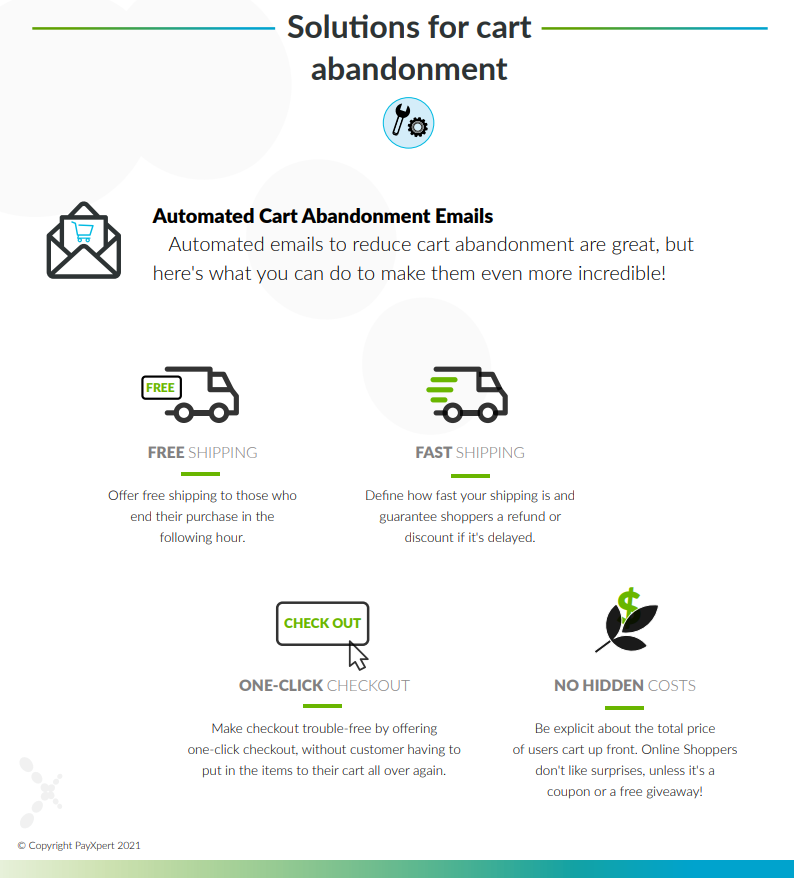Every year, many consumers abandon online purchases because their cards are declined by mistake, they encounter obstacles when completing the process or they cannot find their favourite payment methods. In short, if you are offering a payment and checkout process that is too complex, with too many steps, your customer could end up frustrated and abandon the shopping process.
 Source: Statista
Source: Statista
Have you ever been in a similar situation? If you have an online business, the abandonment rate is probably one of your biggest challenges. The good news is that it can be reduced and, in this post, we will give you some tips on how to do it.
First, we are going to define what this rate is, analyse the main eCommerce pain points and, finally, find out how to correct them. Are you ready to start?
What is the shopping cart abandonment rate?
It is the percentage of online customers who add products to their shopping cart, but do not complete the entire shopping process. In short, they are customers who abandon their shopping cart when they are about to make a purchase. Why? What factors affect this decision?
Shopping cart abandonment rates vary based on the industry you’re working in, what product you’re selling, and who exactly you’re selling to. Below we share with you some key KPIs related to the abandoned cart rate:
Below we share with you some key KPIs related to the abandoned cart rate:
- Value. It refers to the total monetary value of the abandoned purchase.
- Number of items. This is the total number of products that have been abandoned when leaving the website.
- Transaction path length. These are the number of steps the customer takes from the start of the purchase until the end of it.
Do they sound familiar?
Top 10 pain points influencing abandonment rate
The shopping cart abandonment rate is one of the main problems of any online store. It is also a major challenge for eCommerce. For this reason, we would like to share with you the main factors that influence cart abandonment:
- Confusing prices.
- Unexpected costs that break with customer expectations and increase their mistrust.
- Few alternative payment methods.
- Lack of a unified login and a common interface to avoid being directed to an external page.
- A website that takes too long to load at checkout.
- Too many steps in the checkout process, which hinders the user experience, causing boredom, frustration and confusion.
- Lack of trust in the payment gateway. When the user has to enter their bank details, distrust and fear sets in.
- Lack of optimisation in payment processes.
- Limited possibilities when it comes to returning a product.
- Slow shipping and delivery.
Are you clear about why your customers leave your online store without buying? Research, analyse and change.

How to reduce shopping cart abandonment rates
What is going wrong when selling your products online? Why do some customers abandon the shopping cart before checkout? The pain points mentioned in the previous section are a key indicator of your business’ health. They also provide insight into what is going wrong in the sales process.
The checkout process shouldn’t be complicated for your buyers. By focusing on the following cart optimisation tips, you’ll get a seamless shopping experience on your site:
- Send personalised follow-up emails. Remind customers they haven’t completed their purchase and give them the ability to pick up where they left off.
- Use Multi-buy offers. Multi-buy is a tool for all business merchants that lets you offer a discount to your shoppers the more they buy the same item.
- Add customer testimonials and reviews. Fill up product pages with recommendations from other happy clients to help communicate the value of your products.
- Unexpected delivery costs. Be transparent and offer clear shipping options, customers may re-evaluate their purchase if they see extra fees.
- Offer live chat support. Detect areas where shoppers are more likely to drop off and allow them to chat with a support agent to reduce abandonment.

There are many customers who encounter these and other setbacks when they decide to buy online but correcting them is a possibility that is only up to you. If you have a slow, complex, and unintuitive navigation… it is time to optimise your purchase flows and reduce the abandonment rate!
To do this, payment gateways have become an essential tool to correct the drawbacks and boost sales. In turn, they should offer:
- Different payment methods tailored to your customers’ local needs and preferences. For example: if your business regularly receives purchases from Chinese customers, or you would like to expand your borders, you might want to include some of the most popular methods in China, such as WeChat Pay or Alipay.
- Data management to get an overview of your business operations. Look at your abandonment funnel to see on which pages most customers abandon the shopping/transaction experience and then look at strategies to reduce this leakage. That’s the first step towards lowering your abandonment rate.
- Business Intelligence. Develop your own A/B testing by designing new changes to the checkout process to see if this has a positive or negative impact on the checkout abandonment statistics
- Global Payment Offering consumers international card payments opens a world of possibilities to increase sales. No matter if you sell in an online or a physical store, it is key that you accept popular payment methods used by consumers in different markets.
- Omnichannel payment methods. It is essential to the user experience with your online store. In fact, today’s market is marked by the integration of all contact channels, so that the user perceives a unique experience.
Can I really find all this in a payment gateway? Yes, you can. And if you have any doubts, you can ask us at PayXpert.
Tips to reduce the abandonment rate in your online store
Beyond the technical aspects, the way you manage payments in your business, and the experience you offer to users who visit your online store, there are some basic recommendations that can have an impact on reducing shopping cart abandonment.
Do you want to know what they are? There you go:
- Optimise page load speeds. Having a high-speed loading page can assure your shoppers’ need for a speedy checkout experience.
- Incorporate progress indicators on the checkout page. A progress indicator helps buyers realise where they are in the checkout process, and how much further they must go.
- Optional registration. Locking the checkout behind a user wall can discourage potential customers, offer the ability to check out as a guest instead of forcing account creation.
- Provide several payment options. Today’s shoppers have access to multiple payment alternatives such as QR codes, digital wallets, credit cards, etc.
- Exit-intent pop-up. Add a feedback loop that is displayed when buyers abandon their shopping cart. These pop-ups can explain why users are abandoning their cart or be used to surface a promotional discount.
Do you have any questions about how to reduce the abandonment rate in your online business? At PayXpert, we can guide you on your way to optimisation.




